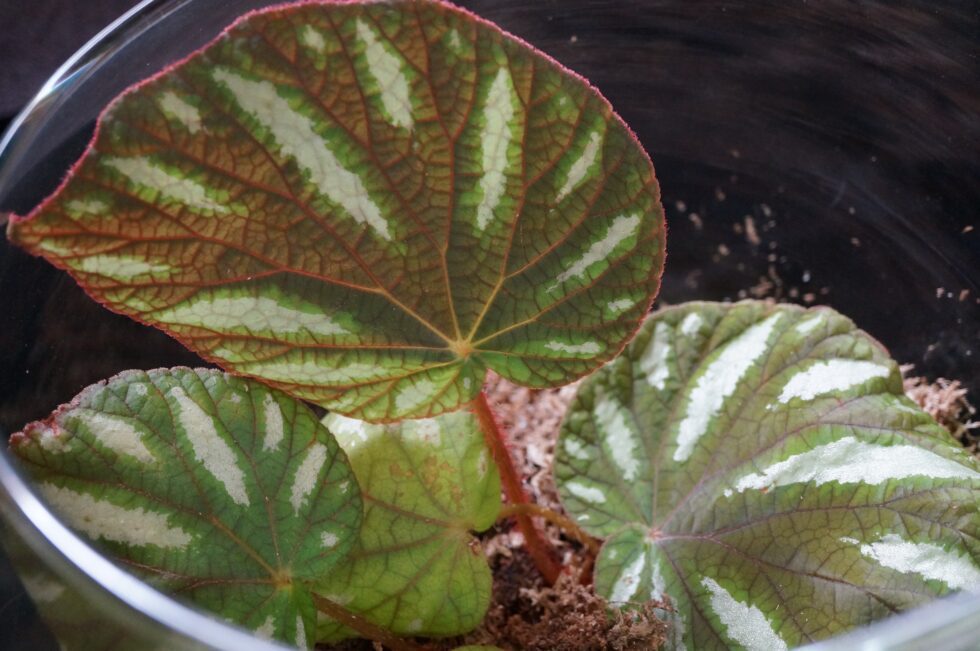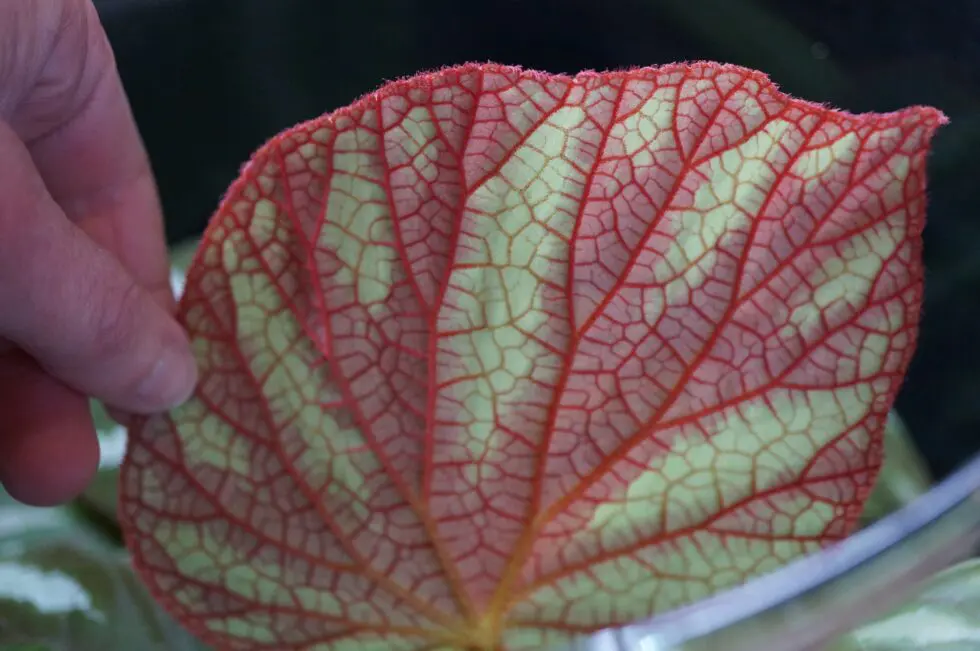
B. iridescens
MEMBER NAME: ABS member, Northern Virginia
SPECIES NAME: Begonia iridescens
[1] SHADE: SEMI-SHADE: SUN: TERRARIUM: FLUORESCENT LIGHTS
My plants have been grown in a terrarium or in the walk-in-terrarium where the humidity is 65%. The plant in the walk-in-terrarium is struggling. Initially, the plant was grown under two full-spectrum fluorescent lights, but the leaves began to curl under at the tip and edges of the leaves. I moved the plant to an individual stand between the two light stands where the light is bright, but less intense, and the leaf curl was less pronounced.
[2] TYPE OF GROWING MEDIUM USEDMy plants are grown in lightly moistened, chopped, long-fibered sphagnum moss placed over a thin layer of horticultural charcoal, which is placed over a thin layer of perlite. In their native habitat, B. iridescens leaves grow pressed against rocks or soil. To keep the leaves from touching the moist sphagnum moss, I placed Vole Block (expanded slate pebbles) on top of the moss.
[3] TYPE OF FERTILIZER AND FREQUENCY OF FEEDING
The plants are fertilized with ¼ strength fertilizer each time I water.
[4] MOISTURE REQUIREMENTS AND METHOD OF SUPPLYING APPROPRIATE AMOUNT OF WATER
(A) frequency of watering (B) water from the bottom (C) wick water
Because B. iridescens leaves naturally grow pressed against the ground or rock on which they are growing, all the lower leaves are lying on the moss/VoleBloc or on each other. I water only when the medium is almost dry, and use a watering can with a long narrow spout to put the water directly onto the medium. Even with careful watering, moisture can build up on the leaves that are covered by other leaves. A few emerging leaves have rotted, but none of the adult leaves have rotted yet.
[5] PEST PROBLEMS AND HOW YOU TREATED THESE
Mealybugs and tiny snails are the only pests I have had in the terrarium. I have used a Q-tip soaked in alcohol for mealybugs, if there has been one or two present. Occasionally I have sprayed the plant with Milstop. For larger infestations, I put a cut portion of a NoPest strip or a dog’s flea collar into the terrarium and seal it in double plastic bags for a few days. For slugs or snails, I fill a few bottle caps with Sluggo or Escargot and place them in the terrarium.
[6] NOTE DOWN YOUR EXPERIENCE OF SETTING SEEDS AND GROWING SEEDS OF YOUR SPECIES
I have been unable to set seeds.
[7] NOTE DOWN YOUR EXPERIENCE OF VEGETATIVE PROPAGATION
(A) rooting leaves &/or stem & leaf (B) dividing rhizomes or roots
Leaves, leaf wedges, rhizome cuttings, and division of the plant have been successful.
[9] OTHER
At the Houston Convention last May, I won a small plant of Begonia iridescens that Rekha Morris auctioned to benefit the Conservation Fund. I am delighted with the plant that has developed from that prize.
B. iridescens is a rhizomatous begonia that has been found in the Abor Hills in the eastern Himalayas, and on the frontier of Burma and Tibet.
Rekha’s notes indicate that the plants she found were located in a gorge near Gohpur in E. Siang, Arunachal, India. It was assigned the Unidentified Species Number 547 (U547).
Rekha stated that B. iridescens is a lower elevation plant, that she found it at fifteen hundred to two thousand feet, and that it was always found growing on a sharp gradient. She said that when she collected it in December, it was the dry season for NE India, and most B. iridescens plants were dormant. Rekha found several plants growing on a steep cliff adjacent to a deep gully where water was trickling down the hill. She writes that B. iridescens is often found growing in rocks with two eight to ten inch leaves pressed flat against the rocks.
Information found on herbarium specimens on the Royal Botanic Garden Edinburgh website, in the South East Asian Database, indicates that B. iridescens was found growing in deep shade at fifteen hundred to fifty-one hundred feet, and was growing flat against rocks or the ground. A note on one of the herbarium specimens also mentions that the collected plant had two large blue-green iridescent leaves growing against soil or rocks.
My plant has about 20 leaves growing from a one-eighth to one-quarter-inch thick light red rhizome that is covered with a moderate amount of medium-length red hairs. Asymmetrical leaves emerge from narrowly triangular persistent stipules. The largest leaves on my plant are five to six inches in length along the center vein and five to six inches wide. Two of the oldest leaves are almost circular in shape; the remaining leaves are asymmetrical broad ovals. All have cordate bases and short acuminate apices. The leaf margins are entire and crenulate. Soft red hairs line the leaf margins; occasional white or red hairs are present up to one-quarter inch back from the leaf edges. The leaves are crisp and damage easily. The leaves gently curl under, perhaps because they have no rocks or firm soil against which they can flatten. Young leaves are red-green; the upper sides of mature leaves are medium to dark green with long silver-white splashes between the veins. The area around the veins retains a red undertone as the leaves mature, especially on the underside of the leaf. The back of the leaf is a medium green with red areas along the larger veins. The veins on the upper part of the leaf are red and depressed which causes a slight puckering of the leaf surface. There are a few widely scattered red hairs on the top of the veins. The back of the leaves have raised red veins that are covered with short red hairs. The one to four-inch petioles are green with a moderate covering of red hair and attach to the leaf at a pale red umbo.
My plant started to form an inflorescence for the first time in early February. At this time, there are only two male blooms on the plant. The blooms are pale pink with four tepals. The two larger outer tepals are pale pink with red hairs on the middle and lower back of the tepals. The two smaller inner tepals are very pale pink and have shallow notches on the outer tips of the tepals. The blooms are one and one quarter inches long and wide. Bracts are green and triangular; peduncles and pedicels are green covered with medium-length red hairs. The female bloom has formed, but not yet opened.When I returned home with my new plant, I put it, pot and all, into a terrarium to recover from the trip. When a new leaf started to unfurl, I felt that the plant would tolerate being moved into a new container and medium. Rekha’s description of B. iridescens habitat suggested that it would prefer a free draining medium. Although Rekha wasn’t certain that B. iridescens would need a terrarium, I wanted to be able to control the growing conditions until I learned more about the plant. I mixed a handful of perlite with my usual chopped sphagnum moss and placed that mix over perlite and charcoal. Since I didn’t have a rock crevice, slabs of rock, or a cliff handy, I spread VoleBloc over the surface of the moss before putting the plant into the medium. The VoleBloc keeps the leaves lifted slightly off the damp sphagnum moss. VoleBloc is a commercial product made up of pebble-sized pieces of expanded slate.
Initially, I placed the terrarium on a plant stand under two full spectrum fluorescent lights. When the leaves began to curl under, I thought the plant was receiving too much light, so I moved it to a small table between two plant stands where it would receive bright, but less intense light. The leaf curl is less away from the direct light, but the leaves still curl under slightly as they mature. It is growing well in lower light and has developed its first inflorescence. Watering the plant has been a challenge.
Because B. iridescens leaves naturally grow pressed against the ground or rock on which they are growing, all the lower leaves are lying on the moss/VoleBloc or on each other. I water only when the medium is almost dry, and use a watering can with a long narrow spout to put the water directly onto the medium. Even with careful watering, moisture builds up on the leaves that are covered by other leaves. A few emerging leaves have rotted, but none of the adult leaves have rotted yet. I fertilize three to four times a year with a liquid fertilizer at one-quarter the strength recommended on the label. The leaves are continuing to grow, and it may soon outgrow the eighteen-inch terrarium in which it is growing. I do have a larger terrarium, but I am hoping that it may be able to tolerate the sixty-five percent humidity in the walk-in-terrarium.
I have started leaf wedges, and hope to try a plant out of an enclosed container soon. Charles and Leora Henthorne are planning to donate B. iridescens plants for an auction after their terrarium seminar. Perhaps the fortunate winners will share their experiences growing this beautiful plant.
- Hughes, M. and Pullan, M. [2007]. Southeast Asian Begonia Database. Electronic publication accessible via www.rbge.org.uk
- Morris, Rekha. Personal communication via e-mail. 9/29/2008

B. iridescens | Photo: Sally Savalle

